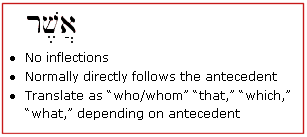|
Introduction to the Relative Pronoun
In English, a relative pronoun (who, that, which) connects a modifying clause to an antecedent. This clause is called a relative clause since it "relates" the clause to the antecedent and modifies it adjectivally. For example:

In the sentence above, the pronoun "who" relates the following clause (indicated in brackets) to its antecedent, "the man." The clause itself functions as an adjective, since it modifies the word "man" by further qualifying him as a teacher of truth.
The Hebrew Relative Pronoun
The relative pronoun asher occurs over 4,800 times in the Tanakh and functions in a similar way. The form of asher takes no inflections (i.e., no different spellings for gender, number, or definiteness) and normally appears directly following the antecedent.

Examples

In the example above, the relative pronoun "asher" relates the following clause to its antecedent, "the young man." The clause itself functions adjectivally, since it modifes the word "hana'ar" by further defining him as one who sat in the house.

In the example above (Psalm 1:1a), the relative pronoun is used to qualify the description of the happy man. This is the man who has not walked in the counsel of the wicked.
The word ka'asher means "just as" or "as," and is formed by prefixing the letter Kaf to the relative pronoun asher:

This phrase would be translated as "just as the LORD, the God of Israel, commanded." We will look more at ka'asher later when we study verbs.
In modern Hebrew (Ivrit) the relative pronoun can appear as the prefix Shin with a dagesh forte in the following letter (if the letter is a non-guttural). This form also occurs in some poetic passages of the Tanakh.
Note: Since I have not presented verbs or prepositions yet, I can only provide some simple guidelines regarding the usage of the Hebrew relative pronoun. Later, when we study verbs, more information will be presented about how they operate in Hebrew sentences. For now, it will suffice to memorize the word asher and be familiar with the grammar of the relative clause.
Section Exercises
- Memorize the vocabulary at the top of the page.
- Summarize the usage of the relative pronoun on a small flashcard.
- Write some simple examples (in English and Hebrew) to help you remember the rules.
<< Return
|



